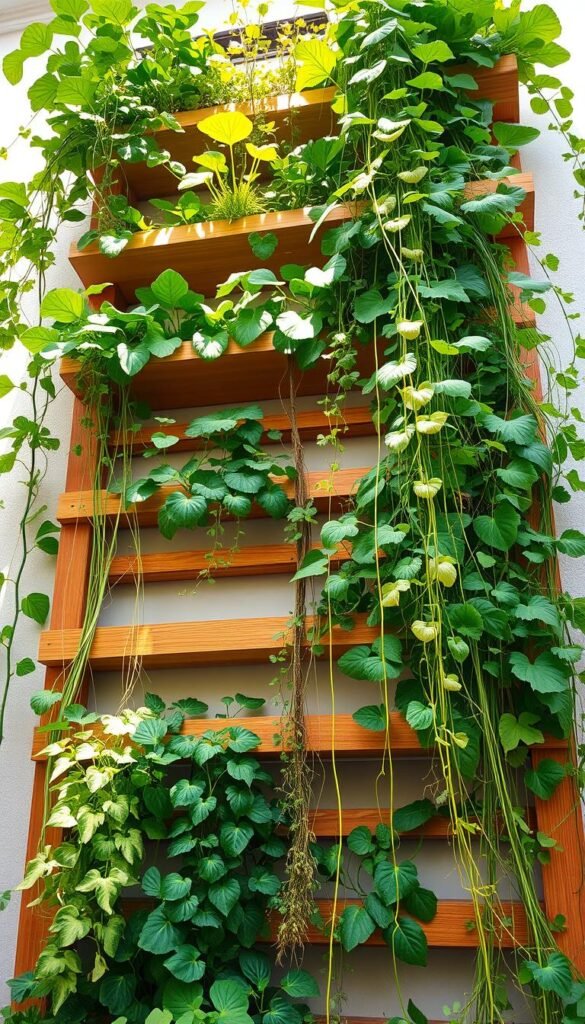Ever felt stuck with a cramped patio or balcony that seems too small for growing fresh food? Imagine turning those overlooked corners into lush, edible displays. That’s exactly what I wish I’d known years ago when my “outdoor area” was just a 10-square-foot porch. Back then, I didn’t realize how much potential those walls and railings held.
Growing upward changes everything. Instead of spreading plants across limited ground space, you use height to multiply your planting zones. Think hanging planters, wall-mounted pockets, or tiered structures. Even a single sunny wall can host herbs, greens, or compact fruiting plants.
You don’t need fancy tools or a big budget. Old pallets, repurposed gutters, or basic wooden frames work wonders. The trick is choosing spots that get at least 6 hours of sunlight daily. South-facing walls? Perfect. Narrow balcony rails? Ideal for attaching containers.
This approach isn’t just practical—it’s transformative. One gardener I know tripled their harvest by stacking pots on a simple shelving unit. Whether you’re working with a fire escape or a postage-stamp backyard, smart vertical solutions let you grow more than you’d expect.
Getting Started with Vertical Gardening Basics
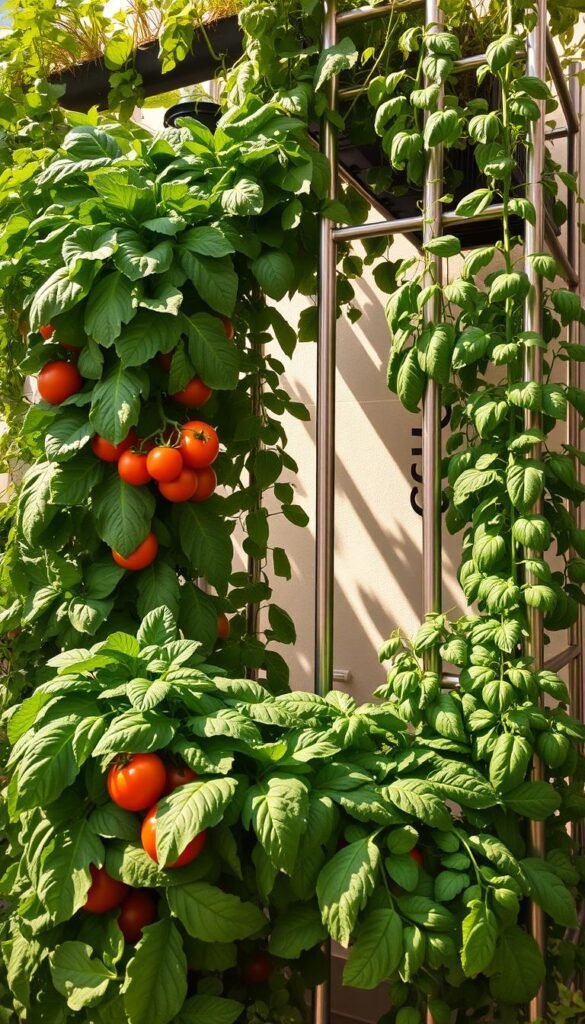
Have you ever looked at a blank wall and imagined it bursting with fresh herbs and veggies? This ancient growing method – used in Babylonian hanging gardens – now solves modern space challenges. By stacking plants upward, you create living walls that feed families and beautify areas.
Why Grow Up Instead of Out?
Elevated planters keep leaves away from soil-dwelling pests. Air moves freely around leaves, reducing mold risks. Harvesting becomes easier too – no more bending over tomato plants. One urban grower reported 90% fewer slugs after switching to wall-mounted planters.
The Space Multiplication Effect
A 10-square-foot vertical setup can hold as many plants as 30 square feet of traditional beds. Try this comparison:
| Layout | Plant Capacity | Harvest Frequency |
|---|---|---|
| Ground-Level | 12 plants | Every 5 days |
| Vertical | 36 plants | Every 3 days |
This method shines in small backyards where every inch counts. You’ll use walls, fences, and even stair rails as growing surfaces. One gardener transformed a fire escape into a salad bar with hanging lettuce planters.
Vertical Vegetable Garden Design: Save Space with Trellises, Shelves, and Towers
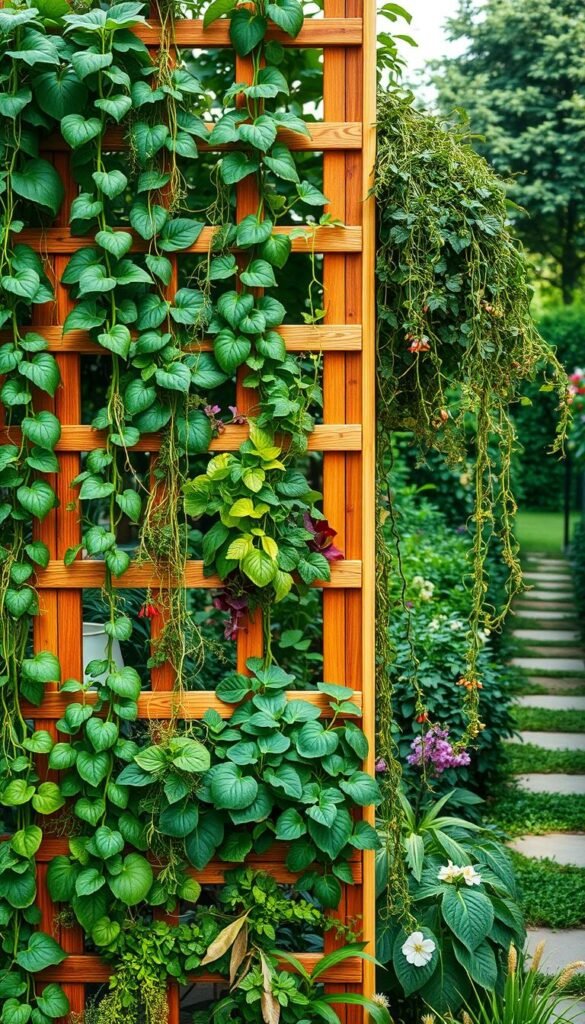
What if your walls could harvest tomatoes while your railings grow herbs? Three core structures make this possible:
- Climbing frames for beans and cucumbers
- Stacked platforms for herbs and leafy greens
- Columnar planters for strawberries and compact veggies
Start by measuring sunlight patterns. South-facing surfaces suit heat-loving plants like peppers. Shaded areas work for mint or spinach. A baker friend transformed her kitchen wall into a thyme-and-basil haven using magnetic planters.
Combine structures based on your crops. Try this layout formula:
| Structure | Best For | Depth Needed |
|---|---|---|
| Climbing Frames | Vining plants | 6-12″ |
| Stacked Platforms | Herbs/lettuce | 8-10″ |
| Columnar Planters | Root vegetables | 12-18″ |
Layer taller plants behind shorter ones to prevent shading. Use lightweight soil mixes to protect wall mounts. One urban grower alternates rosemary towers with hanging cherry tomatoes – “It’s like edible decor” they say.
Your final blueprint should balance function and visual flow. Test arrangements with paper cutouts before installing. Remember: good design solves space puzzles while feeding your family.
Repurposing Everyday Items for Your Vertical Garden
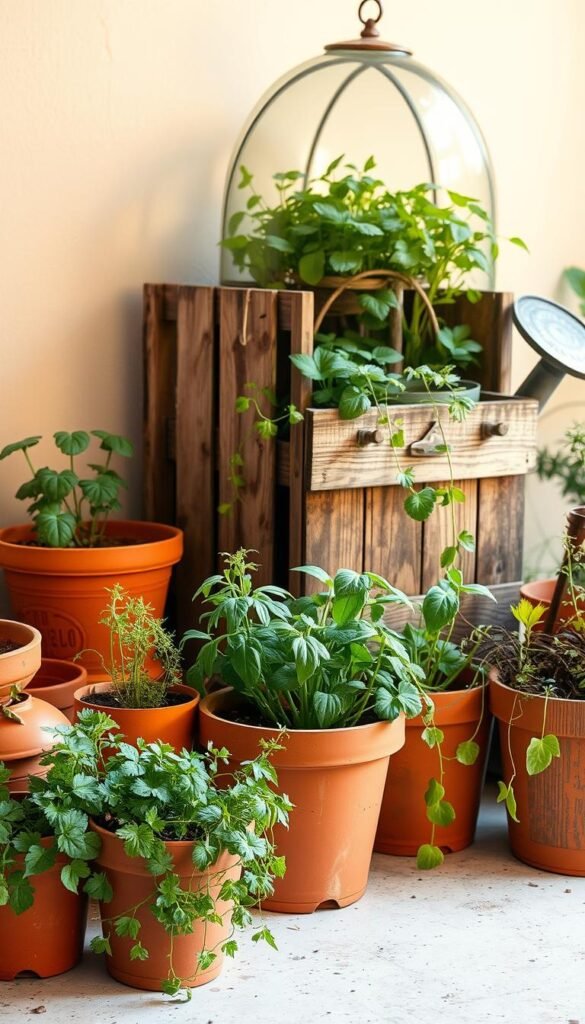
Got old shoe organizers collecting dust? That fabric hanging storage could become your next strawberry patch. With simple tweaks, everyday objects transform into high-yield growing systems that cost pennies to create.
Transforming Hanging Shoe Storage and Window Boxes
Turn fabric shoe organizers into herb havens in three steps:
- Poke drainage holes in each pocket using a heated nail
- Fill with lightweight potting mix
- Hang where sunlight hits for 4+ hours daily
One urban gardener grows 14 basil plants in a single organizer: “It’s like having pesto on tap.” Window boxes shine beyond sills – stack them vertically using heavy-duty hooks. Attach to balcony rails or chain-link fences for cascading flowers and greens.
Innovative Uses for Wood Pallets
Salvaged pallets become instant plant walls. Secure them upright against fences, then add:
| Add-On | Function | Best Plants |
|---|---|---|
| Pot hangers | Hold container gardens | Cherry tomatoes |
| Shelves | Create planting tiers | Lettuce varieties |
| Fabric pockets | Grow shallow-root herbs | Thyme, oregano |
Always line pallets with landscape fabric to retain soil. For root vegetables, leave 12″ between slats. A Minnesota gardener reported: “My potato yield doubled using pallet towers with proper drainage.”
These hacks prove you don’t need specialty containers. With creativity and basic tools, you’ll turn overlooked items into productive green spaces.
Trellis Techniques to Enhance Your Garden
What if your fence could feed you twice over? Strategic trellis setups do more than support climbing crops—they create bonus planting zones underneath. By pairing vining plants with shade-tolerant companions, you effectively double your growing capacity without expanding your footprint.
Double-Duty Trellis Options for Climbing Vegetables
Maximize every inch by growing two crops in one space. Pole beans climbing upward? Plant lettuce or radishes below. Tomato vines reaching skyward? Tuck basil or parsley beneath. This layered approach:
- Shields tender greens from harsh sun
- Keeps soil moist longer
- Deters pests through natural companion pairings
One urban gardener shared: “My squash trellis now grows spinach underneath—harvests increased 40% last season.”
DIY vs. Store-Bought Trellis Solutions
Choose materials based on your plants’ needs:
| Type | Best For | Cost Range |
|---|---|---|
| Bamboo stakes | Lightweight crops (peas) | $10-$15 |
| Cattle panels | Heavy yielders (tomatoes) | $25-$40 |
| Modular kits | Balcony gardens | $50+ |
For permanent installations, bury wooden posts 18″ deep. Container gardeners can use folding trellises that store flat during winter. Pro tip: Angle structures slightly backward to prevent tipping under plant weight.
Creative Container and Shelf Arrangements
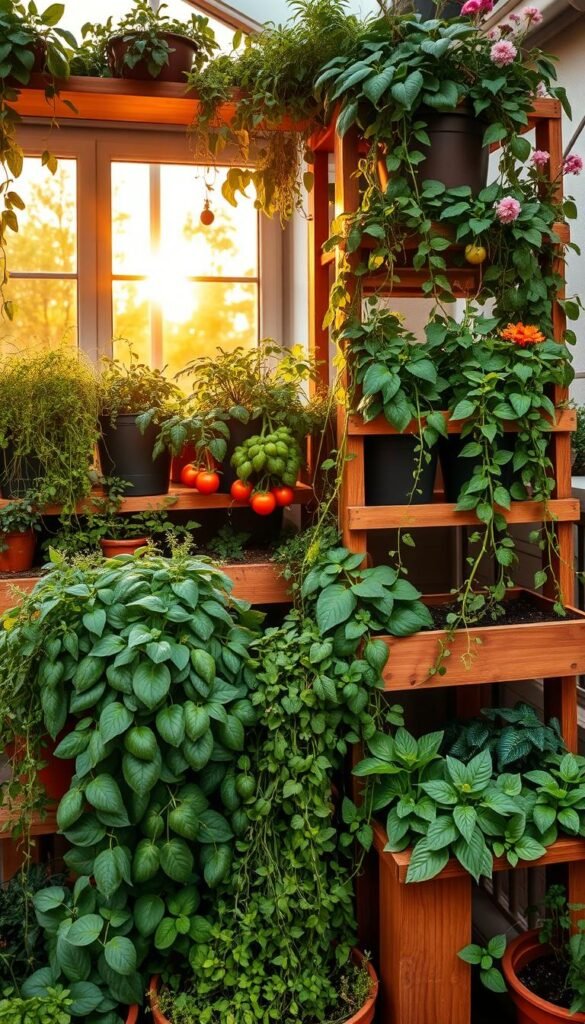
Your unused wall space becomes a powerhouse when paired with strategic stacking. By layering containers and planters, you create edible tapestries that work harder than single-level setups. One urban grower transformed a narrow balcony into a 42-plant oasis using nothing but thrifted pots and basic brackets.
Multi-Tiered Container Gardens Explained
Start with your largest planter at the base—a 14″ pot holds tomatoes while supporting smaller herb containers above. Follow these rules:
- Place heavy items on bottom shelves
- Offset stacked pots for stability
- Leave 6-8″ between tiers for growth
Drainage becomes critical in layered systems. Drill extra holes in container bottoms and add gravel layers. A Texas gardener shared: “My basil thrives since I started using coffee filters under potting mix—no more soil washout.”
Optimizing Shelves and Planters for Vegetables
Match shelf depth to plant needs:
| Vegetable | Ideal Shelf Depth | Light Needs |
|---|---|---|
| Lettuce | 6-8″ | Partial shade |
| Peppers | 10-12″ | Full sun |
| Carrots | 12-14″ | Filtered light |
Rotate planters weekly for even sun exposure. Use adjustable shelving to accommodate changing crops—lower racks for spring greens, upper tiers for summer beans. Pro tip: Line metal shelves with cork tiles to insulate roots from heat.
Unique Approaches: Straw Bale and Ladder Gardens
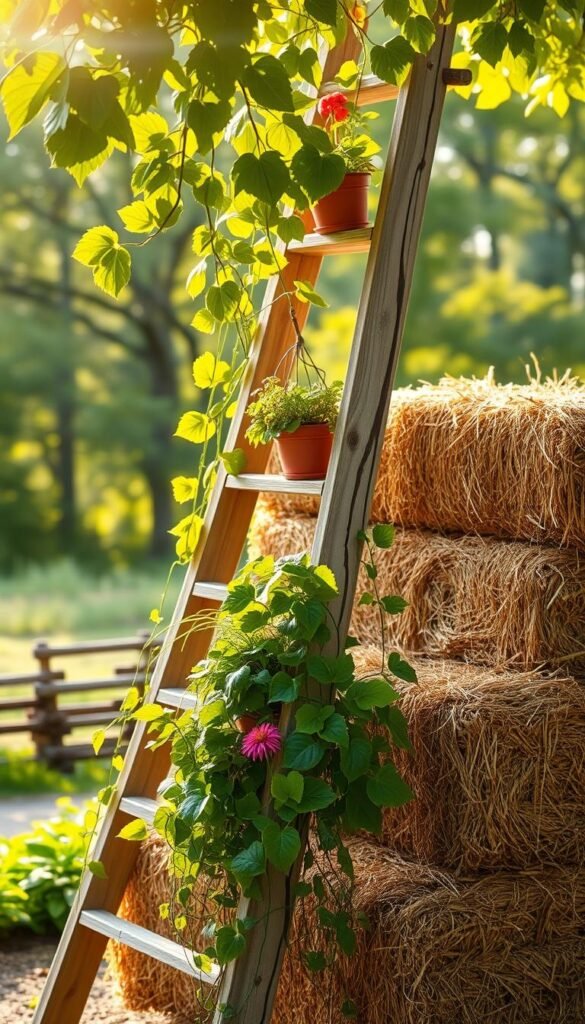
Who knew straw and old ladders could become your garden’s best friends? These unconventional materials offer surprising benefits for tight spaces. Both methods keep plants elevated above the ground while using inexpensive, readily available supplies.
Building a Vertical Straw Bale Setup
Straw bales cost 40% less than wooden raised beds and provide superior drainage. Start by sourcing straw (not hay) from local farms or garden centers. Condition bales for 10-14 days:
- Water daily until interior feels like a damp sponge
- Add nitrogen-rich fertilizer to kickstart decomposition
- Check soil temperature – ready when below 100°F
Secure stacked bales with chicken wire or metal stakes driven through the center. One gardener reported: “My zucchini plants grew twice as fast in straw compared to ground planting last season.”
Revamping Old Ladders for Extra Planting Space
Retired ladders become instant tiered plant stands. Lean them against fences or walls at a 75° angle for stability. Attach these to each rung:
| Add-On | Function | Best Plants |
|---|---|---|
| S-hooks | Hold hanging baskets | Strawberries |
| Wooden shelves | Support potted herbs | Basil, parsley |
| Window boxes | Grow leafy greens | Kale, arugula |
Space plants 6-8″ apart to prevent overcrowding. The ladder’s sloped design lets rain water flow downward, reducing manual watering.
Compare both methods to choose what works best:
| Feature | Straw Bales | Ladder Setup |
|---|---|---|
| Season Length | 1 full growing season | Multi-year use |
| Soil Depth | 18″ (compacted) | 6-12″ per shelf |
| Initial Cost | $8-$12 per bale | Free (repurposed) |
Indoor and Outdoor Vertical Garden Solutions
What if your ceiling could grow dinner while your walls filter the air? Modern growing systems let you transform overlooked spaces into functional greenery. Whether you’re working with sun-drenched windows or shaded corners, these solutions adapt to your home’s unique conditions.
Hanging Planter Ideas for Daylight and Shade
Create floating herb gardens using basic rope techniques. Macramé plant holders need just three materials:
- Cotton rope (¼” thickness)
- Wooden rings for stability
- Plastic liners to protect walls
Suspend these near east-facing windows for morning-loving basil. Darker corners? Try shade-tolerant mint. “My kitchen wall grows 8 culinary herbs,” shares a Colorado gardener. Rotate planters weekly to prevent lopsided growth.
Living Walls and Green Screens
Patrick Blanc’s 1988 breakthrough changed how we use vertical surfaces. Modern home versions use:
| Component | Purpose | DIY Alternative |
|---|---|---|
| Metal frame | Structural support | PVC grid |
| Felt layer | Root anchor | Burlap sacks |
| Drip system | Water delivery | Spray bottles |
Start small with a 2’x3′ section. Choose plants based on wall orientation – succulents for sunny spots, ferns for humidity. Pro tip: Add a timer to your water system for consistent moisture.
These methods turn blank surfaces into breathing art. One New Yorker transformed their fire escape into a privacy screen with edible nasturtiums. Your walls can work smarter – no ground required.
Budget-Friendly Vertical Garden Kits and Practical Tips
What if your gardening setup could expand without breaking the bank? Commercial kits offer plug-and-play solutions for those who value convenience. Let’s explore how to choose smart systems and boost their potential with clever tweaks.
Choosing the Right Vertical Garden Kit
Look for metal frames with rust-resistant coatings – they last 3x longer than plastic. The IA Garden Trellis system stands out with its stackable iron rings. Key features:
| Feature | Benefit | Ideal For |
|---|---|---|
| 15.7″H size | Fits small spaces | Balconies |
| 4+ pots | Expandable setup | Herb collections |
| Zip ties | Secure attachment | Rental homes |
Compare warranty lengths – quality systems offer 5+ years of coverage. One user reported: “These held up through Chicago winters better than my DIY wooden frames.”
Simple, Inexpensive Design Hacks
Boost basic kits with these ideas:
- Clip LED lights to metal frames for night harvesting
- Use S-hooks to hang tools between planters
- Paint supports with chalkboard paint for crop labels
Save time by grouping plants with similar water needs. A Texas gardener shares: “I water my mint wall once weekly – other herbs get thirsty faster.”
Wrapping Up Your Vertical Vegetable Garden Journey
Transforming tight corners into thriving edible displays starts with smart choices. Begin by matching your space and budget to proven methods. Got a sunny fence? Try bean trellises. Working with a shaded balcony? Stacked herb planters thrive there.
Prioritize fast-growing crops like cherry tomatoes and leafy greens for quick wins. These deliver harvests in as few as 30 days, building confidence. Save deeper soil beds for root vegetables once your system matures.
Create a seasonal calendar using these guidelines:
- Spring: Peas and lettuce in vertical pockets
- Summer: Pole beans and tomatoes on trellises
- Fall: Kale in tiered beds
Rotate plantings every 6-8 weeks to maximize yields. One urban grower shares: “My backyard now produces salad fixings year-round using just two stacked planters.”
Remember – success grows from starting small. Test one vertical garden technique first, then expand. Your raised garden walls and hanging systems will evolve into a personalized food factory, bite by bite.

